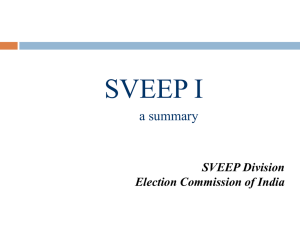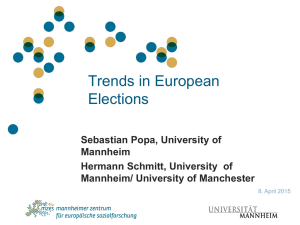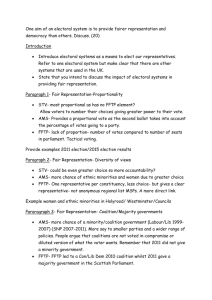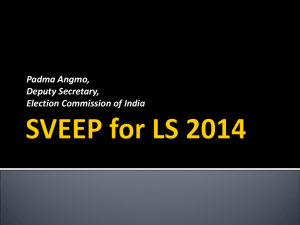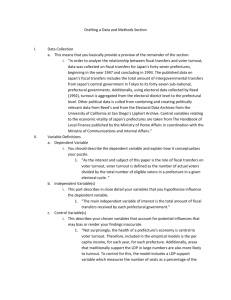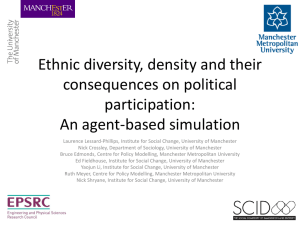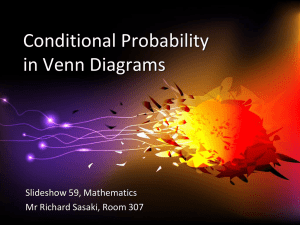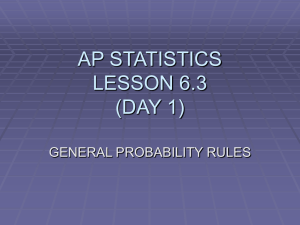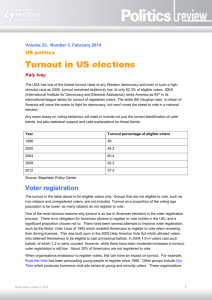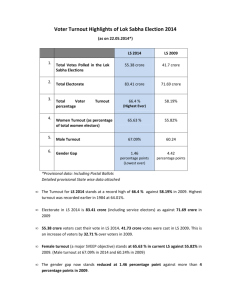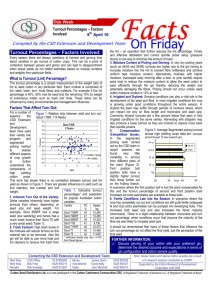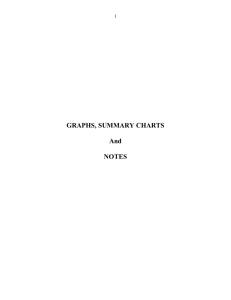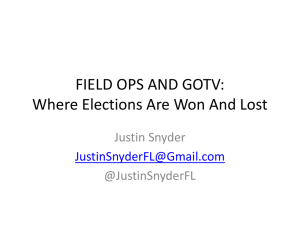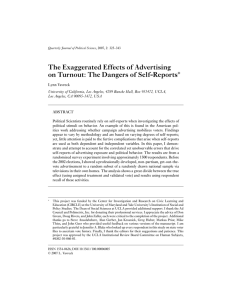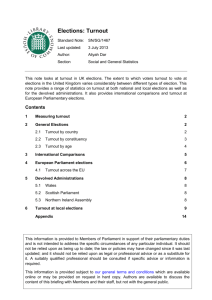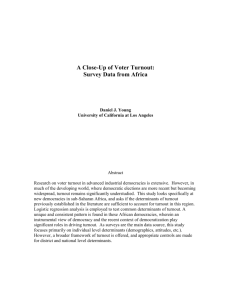S1 Probability and conditional probability
advertisement
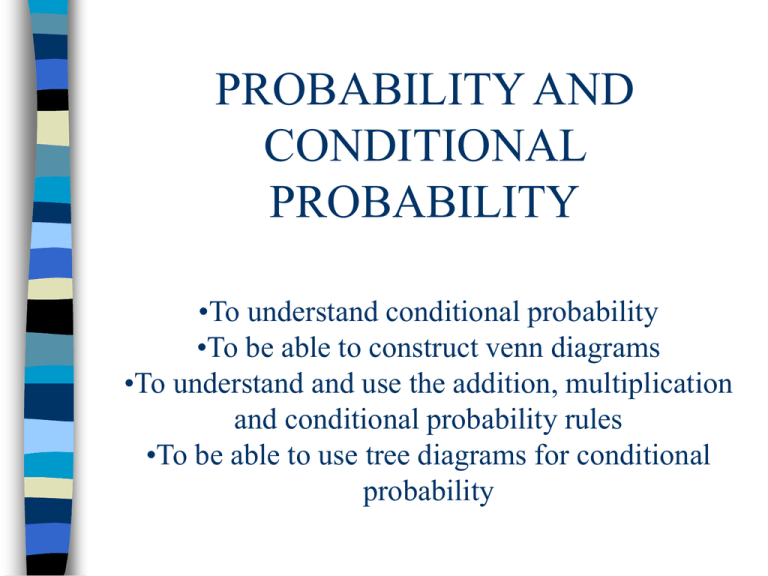
PROBABILITY AND CONDITIONAL PROBABILITY •To understand conditional probability •To be able to construct venn diagrams •To understand and use the addition, multiplication and conditional probability rules •To be able to use tree diagrams for conditional probability A fair die has six faces numbered 1, 2, 2, 3, 3 and 3. The die is rolled twice and the number showing on the uppermost face is recorded each time. Find the probability that the sum of the two numbers recorded is at least 5. (Total 5 marks) + 1 2 2 3 3 3 1 2 3 3 4 4 4 2 3 4 4 5 5 5 2 3 4 4 5 5 5 3 4 5 5 6 6 6 P(at least 5) = 21 = 7 36 12 3 4 5 5 6 6 6 3 4 5 5 6 6 6 A company assembles drills using components from two sources. Goodbuy supplies 85% of the components and Amart supplies the rest. It is known that 3% of the components supplied by Goodbuy are faulty and 6% of those supplied by Amart are faulty. (a)Represent this information on a tree diagram. (3) An assembled drill is selected at random. (b) Find the probability that it is not faulty. (Total 6 marks) (3) 0.03 Goodbuy 0.85 0.97 0.15 0.06 P(not faulty) = (0.85 xA 0.97) mart+ (0.15 x 0.94) = 0.9655 0.94 P(A) = 0.4 P(B) = 0.75 P(A B) = 0.35 a) Draw a venn diagram to show this information (3) b) Calculate P(A B) (1) c) Calculate P(A` B`) (1) d) Calculate P(A` B) (1) A B 0.05 0.35 S 0.4 0.2 a) P(A B) = 0.4 + 0.75 – 0.35 = 0.8 b) P(A` B`) = 0.2 c) P(A` B) = 0.95 CONDITIONAL PROBABILITY The probability of B may be different if you know that A has already occurred. A B a-i i b-i The probability of B given A = i a The probability of P(BA) = P(AB) P(A) S CONDITIONAL PROBABILITY In a class of 20 students 10 study French, 9 study Maths and 3 study both French Maths 7 3 S 6 4 The probability they study Maths given that they study French The probability of P(MF) = P(MF) = 3 P(F) 10 MULTIPLICATION RULE P(BA) = P(AB) P(A) P(AB) = P(BA) x P(A) P(AB) = P(BA)P(A) EXAMPLE 1 2 fair spinners are numbered 1 to 4. They are spun and the sum of the numbers are recorded. Given that at least one spinner lands on a 3, find the probability that the spinners sum exactly 5. + 1 2 3 4 1 2 3 4 5 2 3 4 5 6 3 4 5 6 7 4 5 6 7 8 P(A) = at least one 3 P(B) = sum of exactly 5 P(BA) = 2 7 EXAMPLE 1 2 fair spinners are numbered 1 to 4. They are spun and the sum of the numbers are recorded. Given that at least one spinner lands on a 3, find the probability that the spinners sum exactly 5. + 1 2 3 4 1 2 3 4 5 2 3 4 5 6 3 4 5 6 7 4 5 6 7 8 P(A) = at least one 3 = 7/16 P(A B) = 2/16 P(BA) = P(A B) = 2/16 P(A) 7/ 16 P(BA) = 2/16 ÷ 7/16 = 2/16 x 16/7 = 2/7 EXAMPLE 2 Calculate P(C) = 0.2 a) P(D C) P(D) = 0.6 P(C`D`) P(C D) = 0.3 P (C`D) P(CD) = P(CD) x P(D) P(CD) = 0.3 x 0.6 = 0.18 C D 0.02 0.18 S 0.42 0.38 C D 0.02 0.18 S 0.42 0.38 P(D C) = P(CD) = 0.18 = 0.9 P( C ) P(C`D`) = 0.38 P(C`D) = 0.42 0.2 Tree diagrams and conditional probability P(B|A) P(AB)=P(A) P(B|A) P(A) P(B`|A) P(AB`)=P(A) P(B`|A) P(B|A`) P(A`B)=P(A`) P(B|A`) P(A`) P(B`|A`) P(A`B`)=P(A`) P(B`|A`) Event A Event B Example 1 The turnout at an event is dependent on the weather. On a rainy day the probability of a big turnout is 0.4, but if it does not rain, the probability of a big turnout increases to 0.9. The weather forecast gives a probability of 0.75 that it will rain on the day of the race. a) Find the probability that there is a big turnout and it rains b) Find the probability that there is a big turnout Example 1 The turnout at an event is dependent on the weather. On a rainy day the probability of a big turnout is 0.4, but if it does not rain, the probability of a big turnout increases to 0.9. The weather forecast gives a probability of 0.75 that it will rain on the day of the race. a) Find the probability that there is a big turnout and it rains b) Find the probability that there is a big turnout 0.4 0.75 0.25 P(R) P(R`) 0.6 0.9 0.1 P(B) a) 0.75 x 0.4 = 0.3 b) 0.3 + (0.25x0.9) = 0.525 P(B`) P(B) P(B`) Example 2 A and B are two events P(A|B) = 0.1, P(A|B`) = 0.6, P(B) = 0.3 Find a) P(AB) b) P(AB`) c) P(A) d) P(B|A) e) P(B|A`) Example 2 Find A and B are two events P(A|B) = 0.1, P(A|B`) = 0.6, P(B) = 0.3 a)P(AB) b) P(AB`) c) P(A) d) P(B|A) e) P(B|A`) a)P(AB)=P(A|B)P(B)=0.1x0.3=0.03 b) P(AB`)=P(A|B`)P(B`)=0.6x0.7=0.42 A B 0.42 0.03 S 0.27 0.28 c)P(A) = 0.42+0.03 = 0.45 d)P(B|A)= 0.03 = 0.06 0.45 e)P(B|A`)= 0.27 = 0.490 0.55 Example 2 Find A and B are two events P(A|B) = 0.1, P(A|B`) = 0.6, P(B) = 0.3 a)P(AB) b) P(AB`) c) P(A) P(B) 0.7 P(B`) 0.9 0.6 0.4 e) P(B|A`) P(A) 0.1 0.3 d) P(B|A) P(A`) P(A) P(A`) a)P(AB) = 0.3 x 0.1 = 0.03 b)P(AB`) = 0.7 x 0.6 = 0.42 c)P(A) = P(AB) + P(AB`) = 0.45 d)P(B|A) = P(BA) = 0.03 = 0.06 Note this is exactly the same as the venn diagrams P(A) 0.45

